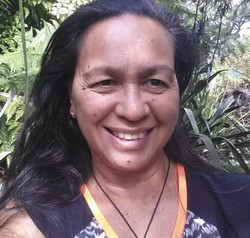Community and iwi-based health and education researchers Dr Tepora Emery (Te Arawa – Tainui) and Dr Candy Cookson Cox (Te Arawa – Ngai Tahu) have delved into Te Arawa’s ancestral history to help develop a suicide ‘postvention’ tool that can support whānau who have lost loved ones to suicide.
In collaboration with key Te Arawa informants, Tepora and Candy are developing a culturally appropriate suicide postvention process and tool that can be used to support grieving whānau. The research project came into being after a spate of suicides among rangatahi in Te Arawa between 2008 and 2012. The Lakes District Health Board Māori team initiated the project and Tepora, as the lead researcher, successfully secured a HRC-funded Ngā Kanohi Kitea community project grant, which is hosted by the Te Arawa Lakes Trust.
The focus of the study, suicide postvention, refers to the forms of support that are put in place for those who are bereaved after a suicide has occurred.
“Studies have shown that post-suicide, there is a heightened risk for suicide to occur again in those who are most vulnerable, particularly the friends and whānau of those who have taken their life. Suicide postvention processes, therefore, can be viewed as preventing suicide. Putting processes in place that are going to protect and secure the future of the coming generations is critical to this end,” says Tepora.
To assist their work, Tepora and Candy interviewed whānau within Te Arawa who have lost a whānau member to suicide, along with key iwi informants. They framed the research as an opportunity for whānau to tell, ‘see’ and share their stories, and as a tool to teach and assist others who have suffered (or may be suffering) from the loss of a loved one to suicide.
“One couple, whose son died 20 years ago, said this was the first time that they had talked about the suicide. People would cross the road when they saw them after it happened as they didn’t know what to say. The dad cried during the interview as it was the first time he had been able to speak openly about what happened since he buried his son all those years ago,” says Tepora.
“Towards the end of our time with them, we asked how they felt about participating in the project. They said it was magnificent because they were now able to remember their beloved son in a more truthful, realistic and understandable way, and felt stronger as a result of the life review process.
“Another participant said, ‘for the first time in my life I feel free; it’s like a curtain has been lifted and I can see.’ It’s been a beautiful research process to take part in.”
After the interviews, Tepora and Candy returned transcripts to whānau for them to review and work on. They then deconstructed and analysed the stories by putting them into a framework. The deconstructed stories were presented back to whānau who were invited to co-construct meaning from them with the help of the researchers.
Through the process whānau have come to a place of learning and enlightenment about their loved ones death by suicide and their own resultant experiences.
“The research method facilitates review, reflection, and restoration – and it works,” says Candy.
The researchers have used a Te Arawa kuia’s touching waiata about a young man who took his own life after losing his mana as the basis for the framework. Candy says the kuia’s waiata, which is still sung today, restores the mana of the young man and that of his whānau. It involves an important process of life review, and illustrates the point that suicide isn’t necessarily something that has to define the deceased or that of their whānau left behind.
“This kuia has shown us that a Te Arawa position on suicide is ultimately compassionate and understanding. The waiata is her legacy and she has left it here for us to discover our own heartsong and to learn from,” says Candy.
With the assistance of Tione Emery, Ngāmaru Raerino and Rawiri Waru, who are the cultural experts and advisors to the research team, the researchers have worked to ensure that the tool is grounded in mātauranga Māori. However, Tepora and Candy both believe that the tool can be used with Māori and non-Māori people who have, or who are experiencing trauma in their lives.
“At the moment we’re thinking about how to teach people to use this tool knowledgably; to make it a user-friendly resource that is accessible to the community. If it can be used to get the results that we’re seeing now that would be amazing. In the next stage of the research we will look to trial it with a wider group of participants, for example, suicide support groups,” says Tepora.
The research team will present the findings of the study to the Te Arawa community in November. They will also present at the Lakes District Health Board’s Research and Ethics Committee seminar followed by the World Indigenous Health Conference in Cairns, Australia, in December.
Read about the experience of one of the study participants in the Rotorua Daily Post.
Read more Māori health research news in the latest issue of e-Pānui.
